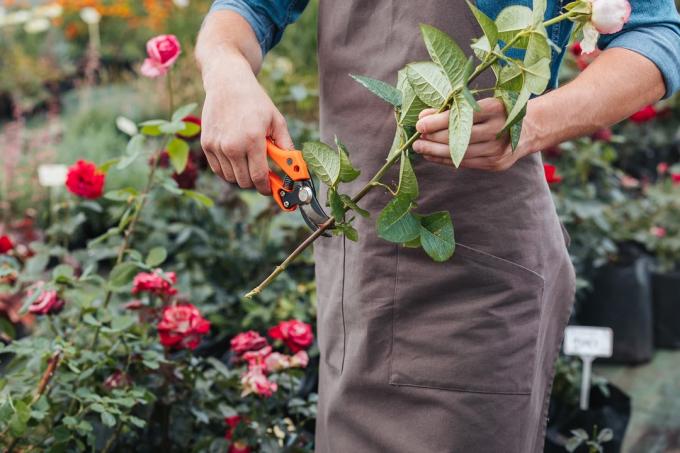
A fragrant bouquet of roses is always a welcome gift that you want to keep for as long as possible. It is important to cut the roses correctly, because even here you can do a lot wrong.
In a nutshell
- Freshness of the roses crucial
- take the right time
- Cut roses at an angle
- Repeat cut several times
Table of contents
- Pay attention to freshness
- The right moment
- Appropriate tool
- pruning roses
- After cutting
- frequently asked Questions
Pay attention to freshness
Fresh roses are a prerequisite for a long shelf life in the vase. Fresher than you can get from your own garden roses hardly be. On the other hand, copies from the trade usually give up quickly.

Therefore, you should pay attention to a few things when buying:
- examine interfaces
- not dark or black, rotted, smeary or otherwise damaged
- all signs of bacterial build-up
- Buds should not be fully open yet
- also not closed anymore
- ideally only slightly open
All of this offers the best conditions for the roses in the vase to stay fresh for a long time.
A notice: It's best to stay away from roses that hang their heads in the shop, because they don't get fresh again if you cut them.
The right moment
Copies from the trade are usually already cut. Nevertheless, as soon as you have them at home, you should cut them again to remove any germs and microorganisms that are already present. The interface is fresh again and the rose can absorb water and nutrients well. roses from the garden it is best to cut them in the morning when they are still well supplied with water.

Tip: It is best to water the roses that you want to cut for the vase thoroughly the evening before.
Appropriate tool
The point of cutting is to enlarge the cut area and expose more conductive pathways. Scissors are completely unsuitable, no matter how sharp they are. With them, the stalks are crushed and the fine meridians inside are destroyed. Water absorption is severely impaired or prevented. Sharp knives are much more suitable.
pruning roses
Roses are hard-stemmed flowers that should always be cut at an angle. The reason for this is the higher water requirement of these plants. A slanted cut creates a larger area over which the rose can absorb more water and nutrients. The cutting surface for a straight cut is much smaller. But what else do you have to pay attention to?
- Remove thorns from the bottom of the stems
- Cut each stem at an angle
- put a sharp knife on the handle
- cut diagonally downwards with pressure
- across the entire width of the shoot axis
- Remove leaves that would reach into the water
- into the water immediately after the cut

Tip: Hybrid tea roses are said to be particularly suitable for vase cutting.
After cutting
After cutting it is important to place the roses in water immediately, ideally in lukewarm water. Leaving them out in the air for just a few minutes can cause the interface to dry and quickly reseal, affecting water absorption. Roses like to stand deep in the water, say at least halfway. In addition, they should be cut again with every water change.
frequently asked Questions
Roses, for example, like lukewarm water that is low in lime and a cool, draft-free place. In addition, the vase should have a wide opening, because roses like to stand loosely, the air should be able to circulate well. The inside of the vase should be smooth, germs can easily collect in grooves and pores.
The best thing to do when buying roses is to keep the distances as short as possible. During transport, the stalks should be wrapped in damp newspaper or damp kitchen towels and immediately cut at home and placed in water.
On average, they last up to 10 days, provided the stems have not been bruised and given proper care. If they hang their heads, this is often due to a lack of water or the roses were no longer fresh.



